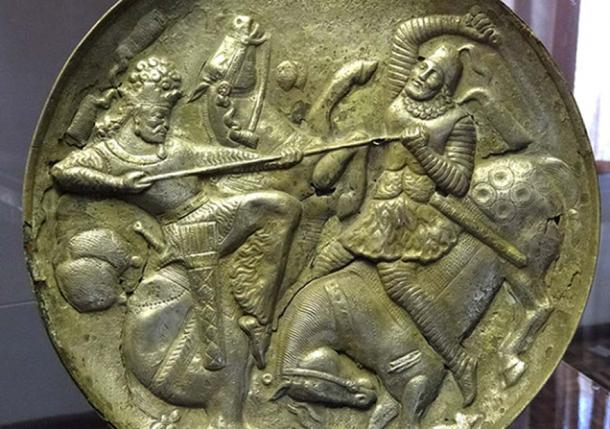Golden Years: Metal Coating Techniques Used 2000 Years Ago Outshine Modern Methods
Ancient technology used by craftsmen 2000 years ago to apply thin films of metal onto their statues surpassed modern standards for producing DVDs, solar cells, and electronic devices. It makes you wonder, how did they do it?
A report on the discovery in the July 2013 issue of Accounts of Chemical Research affirmed:
“[…] the high level of competence reached by the artists and craftsmen of these ancient periods who produced objects of an artistic quality that could not be bettered in ancient times and has not yet been reached in modern ones.”
- The Legacy of Armenia: Trade, Metallurgy, and Forging of Precious Metals of the Ancient World
- Set of 70 Metal Tablets May Have the Earliest Written Account and Depiction of Jesus
- Metals in Bronze Age Weapons Discovered in Sweden Came from Distant Lands

Gold-Plated Silver Dish - Sasavid Period - Azerbaijan Museum - Tabriz - Iranian Azerbaijan – Iran. (Adam Jones/CC BY SA 2.0)
Traditional techniques of fire gilding and silvering are mercury-based processes that have been used to coat the surface of objects such as jewelry, statues, and amulets with thin layers of silver or gold. Often used for decorative purposes, it has also been used to fool purchasers into believing a less precious metal was composed of gold or silver.

11th century A Hoard of Gilded Objects. (Suraj Belbase/CC BY SA 4.0)
2000 years ago, ancient gilders made metal coatings that were especially thin, adherent, and uniform – increasing durability and saving on more expensive materials. This level of quality had yet to be reached in the modern world.
Despite their apparent lack of knowledge of chemical-physical processes, ancient artisans could create amazing results while manipulating metal. One technique they put into practice was to use mercury like a glue and then apply thin films of precious metals to their desired objects.

How artisans centuries ago achieved sophisticated gilding, such as on the St. Ambrogio golden altar from 825 AD, is now coming to light. (American Chemical Society)
The results of the study may aid in the preservation of past treasures, but they also demonstrate how ancient people likely had much more advanced knowledge and skills than many people give them credit for.
Another example of ancient advanced knowledge is the 2000-year-old Antikythera mechanism, a metallic device with a complex combination of gears which apparently worked to calculate solar and lunar eclipses as well as the positions of celestial bodies.
- 3,000-Year-Old Copper Mask Found in Argentina Challenges Ideas of South American Metalwork Development
- The Truth About Father Crespi and His Missing Artifacts Finally Revealed
- More Than Metal: Amazing Historical Suits of Armor

Antikythera mechanism fragment (fragment A). (CC BY SA 3.0)
The Baghdad Battery also usually falls into the category of ancient advanced knowledge. This is a clay pot that holds a copper cylinder with an iron rod at the center – it may be the earliest form of an electric battery.

Three pieces of the Baghdad Battery. (theironskeptic)
Although the level of sophistication 2000 or more years ago may be bewildering for some people today, that doesn’t mean such significant accomplishments should be ignored. Instead, our history books should applaud the ancients’ accomplishments and promote curiosity about how and where the ancient advanced knowledge came from.
Top Image: Detail of a rattle, 1100-1470 AD, Chimu, north coast Peru, gold or gold-plated silver - Art Institute of Chicago. Source: Public Domain




















Comments
We’re still waiting on the Carbon-14 dating test on the iron rod in the Baghdad battery. It’s a cheap/easy test, not like radio-metric, and will tell us the precise era/date when the iron was smelted. Odd why they haven’t done that test. …Or maybe not odd at all.
Nobody gets paid to tell the truth.
The difference between then and now is that we now use machines and computers to do what was once done with hand and brain. We’re no more advanced now than we were then, we’ve just learnt something new and different. Or maybe our reliance on technology means we ourselves are learning less.
In Anglia et Cornubia.